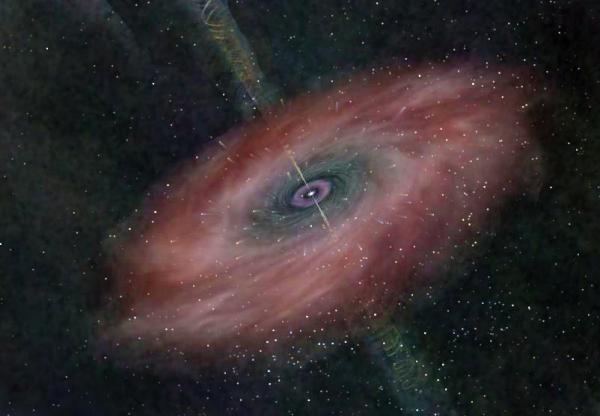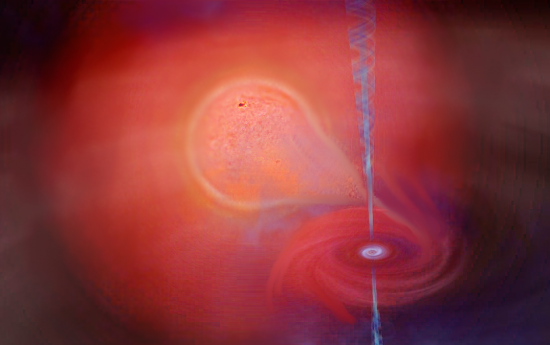BY LETTER
Black Hole
 Image from Steve Bowers |
Naturally occuring black holes
Any massive object (or region) in space that is so dense that within a certain radius (the Schwarzschild radius, which determines the event horizon), its gravitational field does not let even light escape. The hole is surrounded by an event horizon, and anything which passes this horizon (including light) can never escape. However most black holes rotate, some rapidly, and rotational energy can be extracted from (or added to) the hole.Most naturally-occuring black holes are formed from the collapse of a giant star in a supernova explosion. Stars with a mass over 3x that of Sol will inevitably pass at the end of their lifespan through the stage of red supergiants, supernova, and finally black hole. For a typical black hole with a mass of 10x Sol, the Schwarzschild radius is approximately 30 km. Any object falling into a stellar-mass (or smaller) black hole will be ripped apart by tidal forces before crossing the event horizon.
The centre of the Milky Way galaxy (and many other galaxies) contains a massive black hole, which formed in the earliest period of the galaxies' existence.
Artificial black holes
Small artificial black holes have been regularly created since the late First Federation age. Black holes can be made in various ways, such as- using a very powerful explosion to implode an asteroid or small moon,
- striking a very small target from multiple directions with long, thin, very dense impactors at speeds near to the speed of light,
- collapsing a mass of magmatter,
- imploding a wormhole,
- blowing up a massive star, or
- using the same space-time metric technology that generates wormholes to warp space in a somewhat different manner to get a black hole.
Methods 1 and 2 are within the means of modosophont technology, while all the other options require transapientech.
Artificial black holes are much smaller than the stellar-mass holes usually encountered in nature. They can be made large enough to be stable over relatively long periods, or so small that they evaporate rapidly through Hawking radiation. They have many important industrial uses, including power generation in Hawking's Knots, artificial nucleosynthesis in Deep Well Industrial Zones, the production of gravity wells for artificial planets, and enhanced space-time curvature generation or various purposes.
(the term Black Hole was coined by atomic age physicist John Archibald Wheeler).
Useful Tool
Hawking Radiation Calculator Tool Image from Steve Bowers | |
| A black hole in orbit around a red giant | |
Related Articles
- Artificial Planets
- B-Brain, Black Hole Brain
- Cygnus X-1
- Deep Well Industrial Zone
- Hawking's Knot
- Sagittarius A*
- Supermassive Black Hole
- Supernova
- Supernova Remnant - Text by M. Alan Kazlev
The expanding and cooling shell of gas and dust that is visible for thousands of years after a supernova. After a few tens of thousands of years supernova remnants mix with the interstellar medium and dissipate. - Threshold
Appears in Topics
Development Notes
Text by M. Alan Kazlev, with comments by Todd Drashner
Hawking Radiation Calculator by Xaonon
Initially published on 08 October 2001.
Hawking Radiation Calculator by Xaonon
Initially published on 08 October 2001.
Additional Information
Black hole bombs explained
Black hole bomb
Black hole bomb






